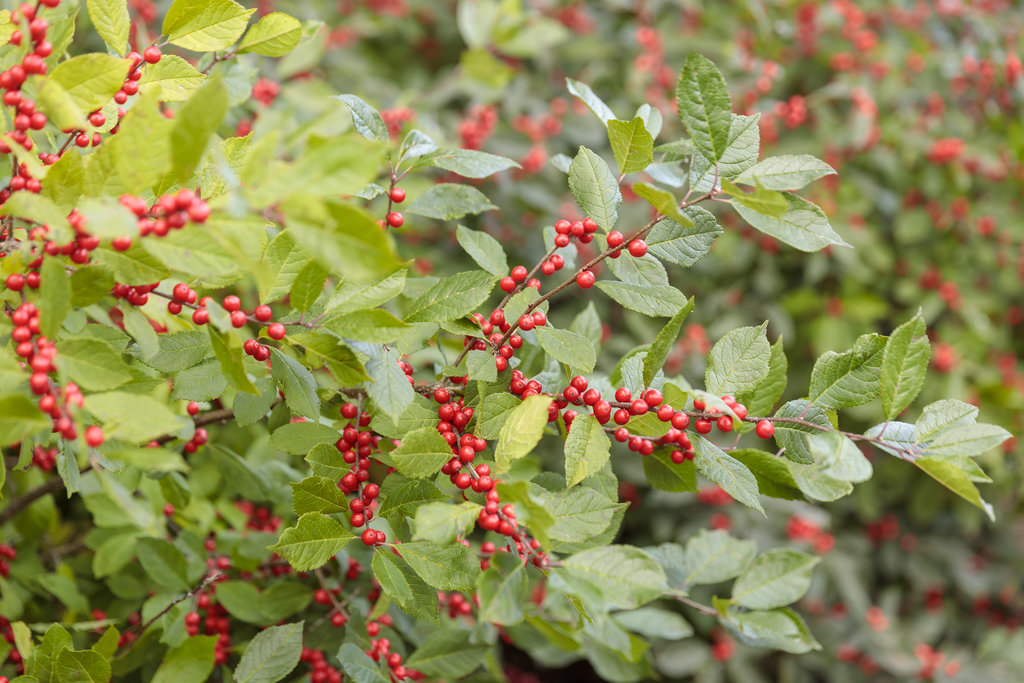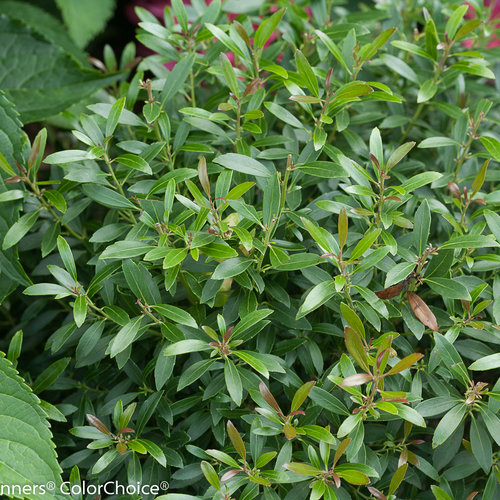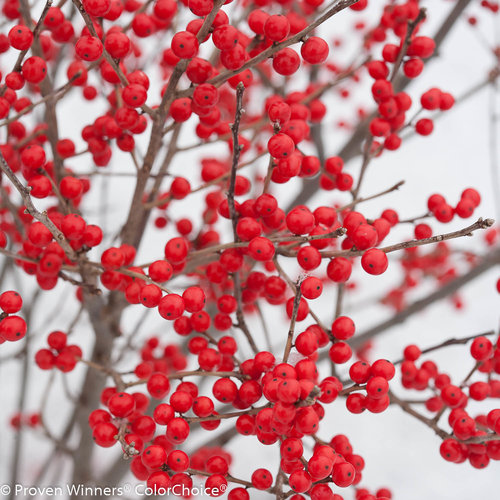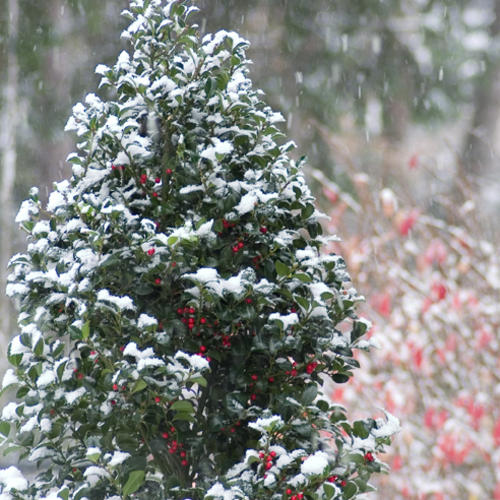Holly - The Ultimate Growing Guide from Proven Winners®
Brightly colored berries, attractive foliage and year-round appeal make holly plants a favorite in home landscapes
 Buy holly plants - Order online and have them shipped right to your door
Buy holly plants - Order online and have them shipped right to your door
Holly (Ilex) is a diverse genus of trees and shrubs, with more than 400 species that occur in temperate, subtropical and tropical regions across the globe. This popular landscape plant is best known for the bright red berries that cheer up the winter landscape and are used to decorate Christmas wreaths and garlands.
With year-round appeal, the evergreen or deciduous foliage comes in different colors and shapes, with small white flowers in spring or summer, and ornamental berries that provide food for songbirds and other wildlife.
The most common types of holly bushes and trees include:
- English holly (Ilex aquifolium)
- Winterberry holly (I. verticillata)
- Japanese holly (I. crenata)
- Blue holly (I. x meserveae)
- Inkberry (I. glabra)
- American holly (I. opaca), which is native to the United States
Holly varieties come in many sizes, from tall trees to dwarf shrubs. They occur in a wide array of forms, including columnar, weeping, conical or rounded. This versatile garden plant has many uses in the landscape, as hedging or screening, in foundation plantings, containers and mixed borders. Here’s how to grow and use holly plant in your yard.
PLANTING & HOLLY BUSH CARE
How to plant: When planting holly, choose a site with full sun to partial shade and well-draining soil. Follow these steps and space plants 2 to 15 feet apart or more, depending on the variety.
- Loosen soil in the planting area.
- Dig a hole twice as wide and slightly deeper than the root ball.
- Remove the plant from its nursery container and tease out the roots if potbound.
- Set the plant in the hole with the top of the root ball level or slightly higher than the surrounding soil.
- Backfill the hole with soil, tamp down lightly to remove air pockets and water well.
- Water regularly until plants are established.
Soil: Holly prefers rich, well-draining soil that's slightly acidic. When planting in containers, use a high-quality, all-purpose potting mix and make sure containers have adequate drainage holes.
Watering: Holly plants perform best with moderate water. Keep soil evenly moist but not soggy. Don’t allow plants to completely dry out, and avoid overwatering to prevent root rot.
Fertilizing: To promote lush, healthy growth, fertilize in spring and again in fall with a slow-release holly fertilizer or other fertilizer especially formulated for acid-loving trees and shrubs.
Pruning: Holly types vary in their pruning needs. In general, plants look their best when allowed to retain their natural shape and size. Remove any dead, diseased, broken or crossing branches and lightly shape as needed. Some types such as Japanese hollies can tolerate heavier pruning and are suitable as formal hedging or topiaries.
TRY THESE PROVEN WINNERS® VARIETIES
Try these holly varieties in your landscape:
Zones: 5-9 Find more boxwood alternatives. |
Zones: 3-9 Learn more about growing winterberry holly. |
Zones: 5-7 |
Zones: 6-8 |
HOLLY FAQ’s
Are hollies trees or shrubs?
Holly plants range from towering trees to small compact shrubs just 2 to 3 feet tall and wide.
Is holly hard to grow?
When grown in the right conditions, holly plants are easy to grow, low maintenance and free of most pests and diseases.
How tall do holly bushes get?
Holly plants can grow 50 feet tall or more, though most garden varieties stay smaller.
When to trim holly bushes?
Prune holly shrubs in late winter or early spring before plants begin to show new growth.
Where is the best place to plant a holly bush?
Choose a site with full sun to partial shade and rich, well-draining soil.
Do holly bushes like sun or shade?
Holly shrubs will tolerate light shade, but will produce the most berries when planted in full sun.
Does a holly bush stay green all year?
Most holly plants are evergreen, though deciduous species such as winterberry lose their leaves in fall.
Find some of the best evergreen shrubs to grow for year-round interest.
Do I need 2 holly bushes?
Nearly all holly varieties are dioecious, producing male and female flowers on separate plants. Female hollies need to be sited near a male plant to be fertilized and produce berries.
Do holly shrubs grow fast?
Most holly bushes have a slow to medium growth rate, increasing in size by 6 to 24 inches per year.
Are holly berries poisonous? Can you eat them?
Holly plants contain saponins, a compound that is mildly to moderately toxic. The berries are not edible, and should not be ingested by pets or children.
HOLLY LANDSCAPING IDEAS
When landscaping with holly bushes, there are many ways to use them in your landscape. Here are some ideas:
- Plant a small holly specimen in a frost-proof container and place near your home’s entrance. Adorn with holiday lights for a festive look.
- Add holly plants to a winter garden alongside witch hazel, hellebores, twig dogwood, winter heath and early-blooming bulbs to cheer up the landscape during colder months.
- Combine smaller specimens in a foundation planting along with other ornamental shrubs for year-round curb appeal.
- Plant a row of an upright evergreen variety such as Sky Box® Japanese holly as a hedge or privacy screen along a fence or property line.
- Place a dwarf type such as Gem Box® inkberry holly in a row along a pathway to create structure between garden areas.
- Use a Japanese holly or other type that’s suitable for shearing as formal hedging to divide garden rooms.
- Mass a smaller variety along a slope to help stem erosion.
- Use as specimens in a mixed border to provide background interest and winter color.
HOLLY COMPANION PLANTS
Combine holly alongside other plants with similar cultural needs of full sun to partial shade and rich, well-draining soil.
For a mixed border, plant with:
- Sweet Sugar Tyme® crabapple
- Perfecto Mundo® Double White reblooming azalea
- Primo® ‘Pistachio Ambrosia’ coral bells
- Shadowland® ‘Autumn Frost’ hosta
For a wildlife-friendly garden, combine with:
- Pearl Glam® beautyberry
- Crusader® hawthorn
- Spring Glory® serviceberry
- Glitters & Glows® arrowwood viburnum
Find more shrubs to attract birds.
For a winter garden, plant with:
- Wedding Party® Confetti Cake lenten rose
- Arctic Sun® dogwood
- Polar Gold® arborvitae
- ‘Miss Piggy’ bergenia
Find more plants for winter interest.
Buy Proven Winners plants:








